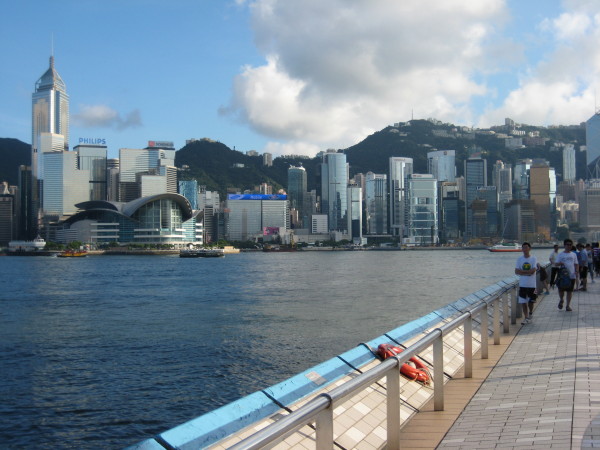“The Government is consulting the public on the setting up of a Harbourfront Authority but both the digest and response form fail to address key concerns,” says Paul Zimmerman, CEO, Designing Hong Kong, and Member, Harbourfront Commission. “These include a lack of oversight over the harbour as a whole; the lack of advisory powers over Government departments; a lack of legitimacy in land allocation; bias towards commercial operations; and a loss of the public voice on the Board.|
Since 2004, Designing Hong Kong has called for an authority to create world class waterfronts. Now they are saying the shortcomings need to be resolved before the community and legislators support the proposal.
“Government wants the authority to be endowed with large waterfront sites. Yet, the vesting of land should be the last, not the first, tool in enhancing the waterfront sites. To start, we need a strategic plan for Victoria Harbour and its 75km waterfront to justify the location of water-dependent land uses – especially the ones nobody wants: pumping stations; sewage plants; waste transfer stations; concrete batching plants; fish and wholesale markets; container and oil terminals; cargo working areas; passenger piers and landings; water sports centres; fuel and water supply stations; police, customs, marine department and fire stations.”
Secondly, Zimmerman continues, the authority must develop waterfront plans for each district along Victoria Harbour, identifying land- and water-based activities and facilities which the local communities want. Such district planning processes are not new. The District Urban Renewal Forum successfully brought together professionals, the Government, district councilors and community to envisage what was required to improve the livability of Kowloon City.
“To intervene, the authority must have advisory powers to guide government to invest in new projects, and to steer works and management at existing sites. This should include road and pavement design, pedestrian connectivity, and cycling and dog walking routes irrespective who manages the land. It should steer the Food and Environmental Hygiene Department (FEHD) so we can eat cooked food outdoors at restaurants and kiosks along the waterfront.”
It is one of the mysterious on Hong Kong that eateries are constantly harried by inspectors who shoo them off open spaces, even those adjacent to their licenced premises, when business and brightness would both be enhanced by having patrons happily ensconced at tables outdoors to everyone’s benefit.
“The authority must advise the funding of projects irrespective of which government department has responsibility,” Zimmerman adds. “Again, this is not a new process. This is already being tested in Kwun Tong by the Energizing Kowloon East Office (EKEO), a works office under the Development Bureau.
“Where a local community has decided that neither the government nor developers can deliver what the people want, only then can a site be proposed for vesting to the authority because of its flexibility in structuring solutions. With well-argued reasons and community support for proposed activities, land uses, urban design and business plans, a project proposal identifying funding gaps can be readily approved by the Legislative Council.”
In a further note he makes an additional observation that the proposed requirement for “financial sustainability” and a “balanced portfolio of projects” would force the authority to not just focus on social objectives, but to pick waterfront sites based on commercial viability rather than community aspirations.
“We need to drop this requirement of financial sustainability. It appears that government’s finance branch is once again meddling with what was supposed to be a good mechanism for delivering a harbourfront for the people. It appears the bean counters consider the setting up of the authority an opportunity to reduce public open spaces, increase development along the waterfronts and reduce public spending. Currently, government normal procedure is that our public spaces are managed by Leisure and Cultural Services Department supported with ample annual funding of operations and ad-hoc funding of projects.”
The government’s proposed focuses on financial sustainability and would create conflicts of interest, making it impossible for the authority to act as an advisor on overall harbourfront planning. And it would no longer be able to comment on the planning of private waterfront sites next door.
The current organisation members of the Harbourfront Commission nominate their own representatives. This has ensured diversity in views, creativity, and transparency. The authority is advised by Zimmerman that they must similarly pursue community appointments.
“With such changes, the authority becomes a benign solution provider rather than a commercial developer. It becomes a partner of the community rather than an aloof institution. It can than create waterfronts which become exemplary public spaces with an abundant choice of activities for all people.”
Many will agree that it is time for government to start spending money on world class design and management of Hong Kong’s waterfronts and not just look at Victoria Harbour, as other residents of Aberdeen, Ap Lei Chau, Tseung Kwan O and Shatin have the same aspirations for their waterfronts – not to mention the Outlying Islands – Cheung Chau having recently suffered yet again the complete clearing of the popular tables all along the ferry side waterfront bearing hot and boring concrete in place of the previous festive air of a celebrating populace.






